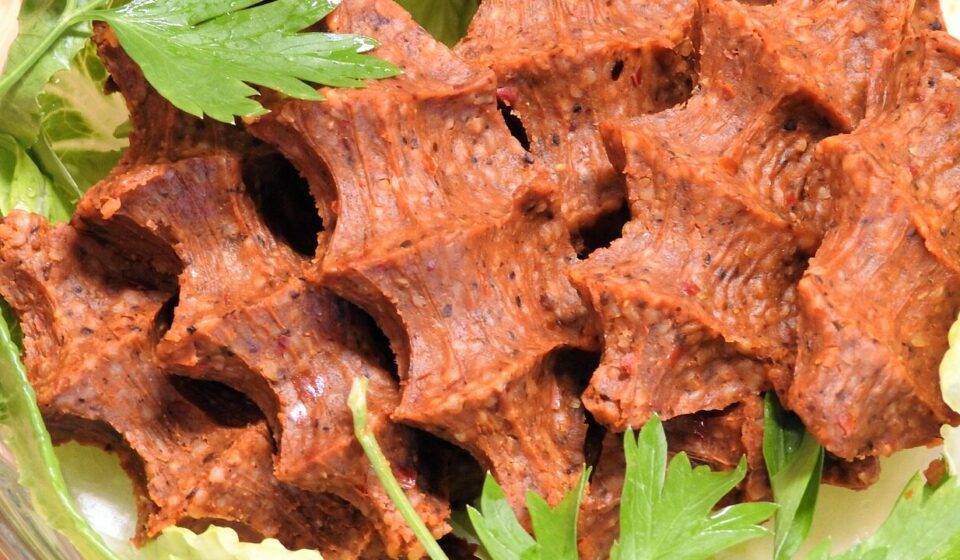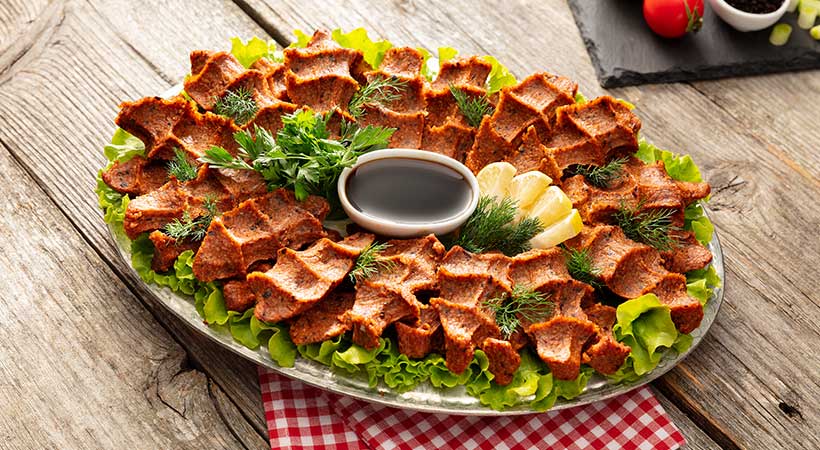
Exploring Çiğköfte: A Delicious Journey into Raw Meatballs
Çiğköfte, or raw meatballs, is a cherished dish originating from southeastern Anatolia, particularly Urfa. Known for its unique preparation using bulgur and spices, this delicacy has evolved to include vegetarian versions, making it a versatile favorite in Turkish cuisine. Join us as we delve into its history, variations, and cultural significance.
Table Of Content
- The Origins of Çiğköfte
- Etymology & Identity
- Nomadic Roots & Agricultural Evolution
- Cross‑Cultural Parallels (Turkish & Armenian)
- Spice Palette & Preservation
- From Past to Present
- Traditional Preparation Techniques
- Ingredients & Quality
- Step 1: Soften the Bulgur
- Step 2: Form the Base with Meat (Traditional)
- Step 3: Build the Spice & Herb Blend
- Step 4: Hand‑Kneading & Cooling Technique
- Step 5: Final Texture & Regional Variations
- The Evolution of Çiğköfte: From Meat to Vegetarian
- Regulatory Shift & Cultural Change
- From Meat to Plant‑Based Foundations
- Urban Vendor Innovations
- Lasting Impact on Popularity
- Cultural Significance and Modern Popularity
- Symbol of Hospitality & Togetherness
- Street Food Culture Across Turkey
- Role in Gatherings & Appetizers
- Modern Popularity & Dual Formats
- Conclusions
- Related Posts
The Origins of Çiğköfte
Etymology & Identity

The origins of çiğköfte trace back to the southeastern region of Anatolia, where this iconic dish has been enjoyed for centuries. The name “çiğköfte” translates to “raw meatball,” a direct reflection of its primary ingredient—raw ground meat, traditionally lamb or beef. However, this dish is not just a simple meat preparation; it embodies a rich tapestry of historical influences and cultural nuances that have shaped its identity over time.
Nomadic Roots & Agricultural Evolution

Çiğköfte is believed to have ancient roots, with its earliest iterations likely originating among nomadic tribes who relied heavily on raw meats in their diet. As these tribes settled and began to cultivate land, the dish evolved, integrating locally available ingredients like bulgur—cracked wheat that complements the meat perfectly. This adaptation symbolizes the intersection of ancient culinary practices with the agricultural advancements of the time.
Cross‑Cultural Parallels (Turkish & Armenian)

The significance of çiğköfte extends beyond Turkish cuisine. In Armenian culture, for example, similar dishes can be found, suggesting a shared culinary heritage influenced by geographical proximity and intercultural exchanges. Both Turkish and Armenian variations of çiğköfte reflect regional specifications in spice blends and preparation techniques, underscoring the importance of this dish not just as sustenance but as a cultural artifact that binds communities.
Spice Palette & Preservation

The recipe itself showcases a wide array of spices that can vary from one region to another, including but not limited to red pepper flakes, mint, and even pomegranate molasses. This diverse flavor profile is a testament to the blend of cultures that interact in southeastern Anatolia. The inclusion of spices not only enhances taste but serves as a preservative—a crucial factor in a time before modern refrigeration.
From Past to Present

Today, çiğköfte is enjoyed in many forms, often served with fresh vegetables and herbs, showcasing its ability to adapt while still honoring its historical roots. The dish remains a popular street food, but its origins remind us of a profound heritage that unites those who savor its unique flavors and celebrate its cultural significance.
Traditional Preparation Techniques
Ingredients & Quality

The preparation of çiğköfte is an art form steeped in tradition that reflects the cultural heritage of Turkey. At its core, çiğköfte comprises a blend of finely ground bulgur wheat, raw meat—usually beef or lamb—and an array of vibrant spices. The process begins by selecting high‑quality ingredients, as the freshness and purity of each component are crucial in creating the dish’s distinctive taste.
Step 1: Soften the Bulgur
First, the bulgur is carefully rinsed and soaked in cold water until it softens, allowing it to absorb the flavors that will be added later.
Step 2: Form the Base with Meat (Traditional)
Traditionally, the raw meat is provided by butchers who are devoted to their craft, and it is imperative that it is as fresh as possible. Once the bulgur is ready, it is mixed with the raw meat, forming the base of the mixture.
Step 3: Build the Spice & Herb Blend
Next comes the pivotal moment in the preparation: the addition of spices and herbs. A traditional mix typically includes isot pepper, along with red pepper flakes, black pepper, and sometimes a touch of cumin. Fresh parsley and finely chopped onions add layers of flavor and texture.
Step 4: Hand‑Kneading & Cooling Technique
To mix the ingredients, chefs use their hands, a practice that integrates the components and imbues the mixture with warmth—essential for the enzymatic activity that helps meld the flavors. Some practitioners add finely crushed ice instead of water; this helps keep the mixture cool and enhances its lightness and texture, ensuring a refreshing bite.
Step 5: Final Texture & Regional Variations
As the mixing continues, the consistency of the çiğköfte becomes vital. The final product should be spreadable yet hold its shape, resembling a smooth, cohesive mass. Each area of Turkey has its own spice blends and additions like walnuts or tomatoes, showcasing regional tastes while staying true to traditional çiğköfte. This meticulous process captures the essence of the dish, preserving both flavor and the cultural traditions embedded within every bite.
The Evolution of Çiğköfte: From Meat to Vegetarian
Regulatory Shift & Cultural Change
The evolution of çiğköfte has been marked significantly by historical and cultural changes, particularly following the ban on raw meat sales in Turkey. The resulting shift forced many street vendors and home cooks to adapt this traditional dish into a vegetarian format, maintaining its essence while forging a path towards health-conscious alternatives.
From Meat to Plant‑Based Foundations
As the raw meat was replaced with bulgur wheat, a staple grain in Turkish cuisine, the foundation of çiğköfte transformed into a vegan-friendly delight. Bulgur became the primary ingredient, not just a filler, but as a canvas that absorbed the rich blend of spices, herbs, and flavors that define çiğköfte. Adding walnuts or pistachios further enriched the dish, offering a delightful crunch while adhering to the ethos of keeping çiğköfte deliciously nutritious. The skillfully crafted blends often include parsley, mint, red pepper paste, and a splash of lemon juice, ensuring that every bite encapsulates the vibrant flavors of Turkish culinary tradition.
Urban Vendor Innovations
In urban areas, street vendors have taken creative liberties by incorporating various vegetables into their çiğköfte, reflecting a growing trend towards healthful eating. Grated carrots, peeled cucumbers, and even avocados make appearances in unique takes on the dish, catering to evolving palates while retaining the essential spirit of çiğköfte. This innovative adaptation highlights how traditional recipes can be dynamically transformed in response to societal changes; what was once a local delicacy bearing meat now flourishes as a versatile vegan dish.
Lasting Impact on Popularity
Health regulations have undeniably left their mark on traditional cuisine, pushing chefs and street vendors alike to be inventive with their ingredients. The ban on raw meat has not led to a decline in çiğköfte’s popularity. Instead, it has birthed a new appreciation for plant-based ingredients and a growing obsession with vegetarian and vegan cuisines in Turkey, showcasing the adaptability and resilience of this iconic dish. As a result, çiğköfte continues to thrive, connecting generations through its flavorful legacy while respecting modern dietary preferences.
Cultural Significance and Modern Popularity
Symbol of Hospitality & Togetherness
The cultural significance of çiğköfte in Turkish society extends far beyond its delightful taste; it embodies a rich tradition that intertwines with daily life, celebrations, and communal gatherings. Traditionally, çiğköfte is not merely a dish but a symbol of hospitality and friendship, often served during festive occasions and family gatherings. Its preparation and enjoyment foster a sense of togetherness, as family members come together to partake in the process of making this iconic dish.
Street Food Culture Across Turkey
As a popular street food, çiğköfte is widely available across Turkey, often found at stalls and tiny eateries known for their quick service and flavor‑packed offerings. Street vendors are adept at catering to the bustling lifestyle of urban centers, serving up to a diverse clientele seeking both convenience and pangs of nostalgia. The vibrant, spicy aroma of freshly prepared çiğköfte draws people in, making it a staple not just for locals but also for tourists eager to sample authentic Turkish cuisine.
Role in Gatherings & Appetizers
Beyond being a savory treat enjoyed on the go, çiğköfte is often chosen as an appetizer at larger gatherings, tantalizing the taste buds and setting the tone for the meal ahead. It serves as a flavorful starter during family meals, special celebrations, or festive gatherings such as weddings and holidays. The variety of flavors, thanks to ingredients like finely minced herbs, spices, and sometimes additions like nuts or vegetables, offers something for everyone.
Modern Popularity & Dual Formats
In modern Turkey, the prevalence of çiğköfte has only grown, with restaurants and fast‑food establishments embracing its allure. They strive to balance tradition with innovation, offering both traditional raw versions and contemporary vegetarian counterparts. This dual approach appeals to traditionalists who cherish the classic flavors and attracts new generations eager for healthier, creative alternatives. The evolution of çiğköfte into a versatile and beloved dish illustrates its adaptability, ensuring its continued relevance in both culinary and cultural contexts across the country.
Conclusions
In conclusion, çiğköfte stands as a testament to the rich culinary traditions of Turkey, with its delightful flavors and adaptability. Whether enjoyed in its traditional meat form or a modern vegetarian twist, this dish continues to captivate palates. Its popularity and cultural importance make it more than just food—it’s a celebration of community and heritage.

